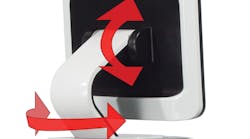Coreless motors that power the pan and tilt of a telemedicine robot’s head let patients position a built-in video camera to give remotely located doctors a good view of things.
The RP-Vita robot from InTouch Technologies Inc., Santa Barbara, has its 49-in.-tall torso topped by a display that acts as the head. Onboard sensors include laser rangefinders and sonar that map the 3D environment to let the robot roam and avoid obstacles. Doctors, patients, and staffers can use the robot’s video and audio facilities to chat remotely via iPad or on site using an onboard touchscreen.
The remote user has full control of positioning the display/video camera combo, but the patient or onsite staff may want to move it as well, either for convenience or to direct the physician’s attention to a different part of the room. The low-torque nature of the coreless pan-and-tilt motors let them tolerate backdriving so patients can position the head with little effort. But the motors also pan and tilt the 5-lb display accurately.
Space constraints force the pan components to sit in the “shoulder” area at the top of the torso. Tilt elements reside where the display attaches to the neck.
The rotor coils of the coreless motor are self-supporting and don’t use an iron core wrapped with copper.Instead, the RP-Vita head uses two coreless motors, both from MICROMO, Clearwater, Fla. Both are 26-mm-diameter dc-brush motors delivering 28 mNm. One works without a gearhead as an input to a harmonic-drive gear system for tilt. The second couples to a low-backlash 14:1 planetary gearhead as an input to a pulley reduction stage for panning.
To monitor absolute position, each axis of motion includes a potentiometer that functions as an absolute position sensor. It comes in handy for orienting the robot in the event of a power interruption. Each axis also has an incremental magnetic encoder to track displacement from a starting point so the user can reposition the display. An FPGA-based controller handles path planning.
InTouch gets the panning motor and gearhead as a subassembly from MICROMO, which also adds low-profile encoder and custom cabling.


